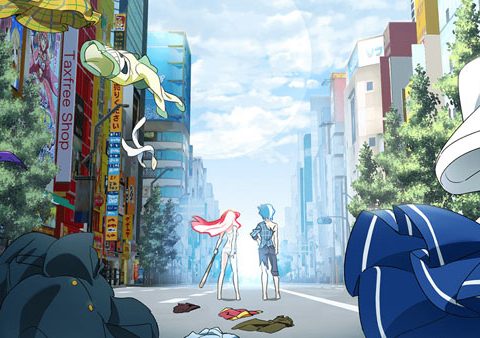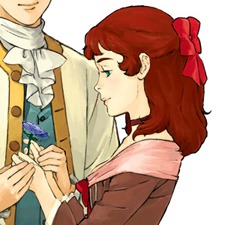Just as in Hollywood, adaptations of videogames to anime have a quite spotty track record. Often it is cited that the games don’t have enough plot or story to fill out a movie or TV series, so the end result is padded out with a lot of filler. Other times what little was there to make good story is corrupted as the studio attempts to insert their own ideas. While there are a lone few examples of game-based anime which has been well received, the genre is largely seen as mediocre and worthy only of the lowest expectations.
 If any game was worthy to make a good anime adaption, it would have to be this one. Released in 2002 and 2003 for Playstation 2, Xenosaga Episode 1: Der Wille zur Macht was really the first game where players reported spending as much or more time watching cutscenes than actually playing the game. While RPG’s have always been a cutscene-heavy genre, and the advent of 3D graphics and FMV technology amplified that tendency, Xenosaga took this practice to the next level. Long before Metal Gear Solid 4: Guns of the Patriots was accused of the same thing, Xenosaga required almost no input from the player for the first few hours of the game as it spent scene after scene fleshing out the plot and characters through voice acted 3D animation. The experience was quite enjoyable, even to a fault, as whenever the game expected you to actually pick up the controller and do something, it felt like a chore.
If any game was worthy to make a good anime adaption, it would have to be this one. Released in 2002 and 2003 for Playstation 2, Xenosaga Episode 1: Der Wille zur Macht was really the first game where players reported spending as much or more time watching cutscenes than actually playing the game. While RPG’s have always been a cutscene-heavy genre, and the advent of 3D graphics and FMV technology amplified that tendency, Xenosaga took this practice to the next level. Long before Metal Gear Solid 4: Guns of the Patriots was accused of the same thing, Xenosaga required almost no input from the player for the first few hours of the game as it spent scene after scene fleshing out the plot and characters through voice acted 3D animation. The experience was quite enjoyable, even to a fault, as whenever the game expected you to actually pick up the controller and do something, it felt like a chore.
In any case, Xenosaga: The Animation is a direct adaptation of Die Will Zur Macht. Over 12 episodes, the TV series covers all the major points of the game’s plot, making only a few alterations and omissions. Indeed, it’s such a close adaptation that much of the dialogue is essentially copied and pasted from the game’s script, word-for-word, and most scenes and locations are easily recognizable from their source. It’s quite possible that there’s never been such a faithful translation of a videogame’s story to another story-telling medium. Unfortunately, Xenosaga: The Animation was perhaps still not translated faithfully enough to flesh out as dense a plot as Xenosaga’s.
 The animation quality and overall production value of Xenosaga: The Animation is average. Despite the very close reproduction of much of the dialog, much of that which is most important to fleshing out the characters is cut or altered. It covers every major scene from the game, but feels rushed – you don’t have time to really enjoy the events and characters for themselves. While Xenosaga’s 12 episodes are much longer, there is a very similar feeling to the Escaflowne movie, which attempted to condense the events of an entire 26 episode TV series into a 1 hour film. Had Xenosaga‘s episode count been doubled to 24 episodes, it perhaps would have faired much better.
The animation quality and overall production value of Xenosaga: The Animation is average. Despite the very close reproduction of much of the dialog, much of that which is most important to fleshing out the characters is cut or altered. It covers every major scene from the game, but feels rushed – you don’t have time to really enjoy the events and characters for themselves. While Xenosaga’s 12 episodes are much longer, there is a very similar feeling to the Escaflowne movie, which attempted to condense the events of an entire 26 episode TV series into a 1 hour film. Had Xenosaga‘s episode count been doubled to 24 episodes, it perhaps would have faired much better.
However, what probably makes the biggest difference is the shift in focus and omission in the development of certain characters. The creators of Xenosaga: The Animation clearly wanted to increase the moe factor of the show, so not content with a single cute little artificial human occupying the stage (named MOMO no less), they pushed an entire array of other 100-series realians into the spotlight, with the angst of one particular attention-starved “Kirschwasser” consuming much of the series’ final story arc. Meanwhile, more interesting adult characters and subplots which were given more attention in the game are skirted around. For example, the fact that Ziggurat 8 committed suicide in his prior life and was re-animated as a cyborg against his will is not revealed and the character is given only cursory glance. Virgil and Cherenkov, two different characters in the game who begin as dislikeable antagonists and prove sympathetic and interestingly complex later, are condensed into a single more simplified character in the anime.
 Xenosaga: The Animation is not really bad, but it’s missing something. Most of the pieces are there, but the fun and intrigue doesn’t come across. The rushed and altered plot doesn’t help, but the truth is that the dialog and even he voice acting is just better in the game. It’s also of note that composer Yatsunori Mitsuda’s music is sorely missed, replaced by a soundtrack which is serviceable but not nearly as effective. All in all, while the graphics of the game are dated by today’s technological standards, the videogame’s cutscenes altogether prove to be a better watch than the TV series. I might recomend the anime to someone who started the game and enjoyed it, but didn’t have the patience for all the tedious RPG battling and upgrades to get through the rest of the story, however given that the story is so heavily condensed and the ending so shifted in focus, its utility in this role is dubious. Die hard fans of the game will no doubt be curious to see the adaptation for themselves and may get a kick out of it, in which case I say “knock yourselves out”, however, as a stand-alone experience, Xenosaga: The Animation is merely average.
Xenosaga: The Animation is not really bad, but it’s missing something. Most of the pieces are there, but the fun and intrigue doesn’t come across. The rushed and altered plot doesn’t help, but the truth is that the dialog and even he voice acting is just better in the game. It’s also of note that composer Yatsunori Mitsuda’s music is sorely missed, replaced by a soundtrack which is serviceable but not nearly as effective. All in all, while the graphics of the game are dated by today’s technological standards, the videogame’s cutscenes altogether prove to be a better watch than the TV series. I might recomend the anime to someone who started the game and enjoyed it, but didn’t have the patience for all the tedious RPG battling and upgrades to get through the rest of the story, however given that the story is so heavily condensed and the ending so shifted in focus, its utility in this role is dubious. Die hard fans of the game will no doubt be curious to see the adaptation for themselves and may get a kick out of it, in which case I say “knock yourselves out”, however, as a stand-alone experience, Xenosaga: The Animation is merely average.
Publisher: FUNimation
Rating: Unrated
Available: 12/23/08





